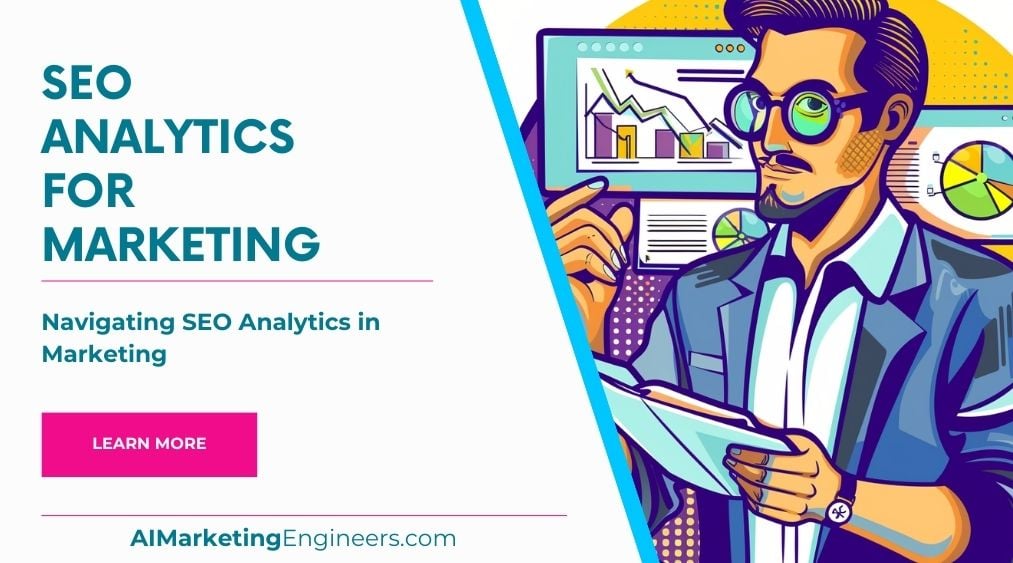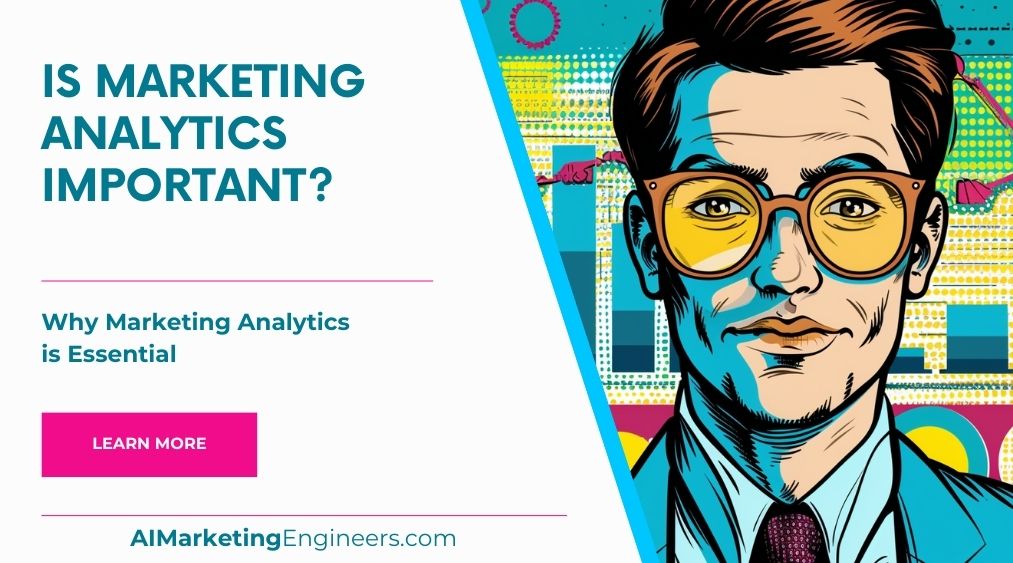Key Takeaways
✅ Personalization: Predictive analytics harnesses historical customer data and behavior patterns to create highly personalized experiences, resulting in a significant boost in customer satisfaction and an increase in sales.
✅ Improved Forecasting: By leveraging predictive analytics, companies can anticipate future market trends and consumer preferences, allowing them to adjust their inventory levels and pricing strategies proactively.
✅ Enhanced Customer Retention: Predictive analytics provides valuable insights into customer behavior, helping businesses identify early signs of churn. Armed with this knowledge, companies can implement targeted retention strategies, such as personalized offers or improved customer service.

Introduction
Are you harnessing the power of predictive analytics to steer your marketing into the future? In an era where data is king, the ability to predict your customer’s next move isn’t just an advantage—it’s a necessity. The role of predictive analytics in marketing is simply transformative, injecting unprecedented accuracy into decision-making processes, heightening customer engagement, and sharpening competitive edges.
This landscape is buzzing with innovation, and those poised to capitalize on it are redefining success. From personalized customer journeys to crystal-clear foresight into demand, predictive analytics opens doors to smarter, more efficient strategies that bolster your return on investment (ROI). As we peel back the layers on cutting-edge models and quantifiable success stories, you’re not just keeping pace—you’re setting the pace.
We’ve lined up a treasure trove of actionable insights and trailblazing approaches to supercharge your marketing outcomes. So ready yourself to delve into this expert guide and unlock the full potential of predictive analytics—where each data point propels you closer to your overarching goals of maximizing revenue, ROAS, and ROI. The future of marketing is written in your data; let’s discover its story together.
Top Statistics
| Statistic | Insight |
|---|---|
| Global Predictive Analytics Market Size: Valued at $7.2 billion in 2020 and projected to reach $28.1 billion by 2026. (Source: MarketsandMarkets) | The significant growth reflects an increasing need for data-driven decision making and personalization in marketing strategies. |
| Improved Customer Engagement: 78% of marketers saw an improvement thanks to predictive analytics. (Source: Evergage) |
This statistic emphasizes the quantum leap in customer interaction, laying the groundwork for deeper brand loyalty. |
| User Demographics – Predictive Behavior Analysis: 49% of marketers currently utilize it to analyze consumer behavior. (Source: Ascend2) |
Nearly half of marketers are tapping into customer insights, a trend likely to increase as competition for personalized experiences intensifies. |
| Healthcare Industry Growth: Expected to dominate the predictive analytics market with a 27.6% growth rate from 2021 to 2028. (Source: Grand View Research) |
The engagement of healthcare is a testament to predictive analytics’ versatility and its critical role in future-proofing various sectors. |
| Cross-Industry Adoption: Predictive analytics use is expected to soar with a 23.4% growth rate across all industries. (Source: Grand View Research) |
This uniform growth indicates a universal acknowledgement of the value brought by predictive insights in strategic marketing decision making. |

Understanding Predictive Analytics
At its core, predictive analytics is all about leveraging data to uncover valuable insights and make informed predictions. The process begins with collecting and preparing data from a variety of sources – customer behavior, past campaign performance, market trends, and more. Statistical modeling and advanced machine learning techniques are then applied to this data, enabling marketers to generate actionable predictions and recommendations.
This powerful combination of data and analytics allows us to anticipate customer needs, identify lucrative opportunities, and optimize marketing efforts for maximum impact. It's a far cry from the days of relying on hunches and educated guesses.
Applications of Predictive Analytics in Marketing
The applications of predictive analytics in marketing are truly diverse and impactful. Let's explore a few key areas where it's making a difference:
- Customer Segmentation and Targeting: By analyzing customer data, we can identify high-value segments and develop personalized marketing strategies to engage them more effectively. Predictive models help us understand what makes certain customers tick, allowing us to tailor our messaging and offerings to their unique preferences.
- Demand Forecasting: Predicting sales and revenue trends is crucial for strategic planning and inventory management. Predictive analytics gives us the ability to anticipate demand fluctuations, adjusting our supply chain and marketing efforts accordingly. This helps us avoid stockouts, minimize waste, and capitalize on opportunities.
- Campaign Optimization: Predictive models can analyze the performance of our marketing campaigns, identifying the most effective channels and tactics. Armed with these insights, we can refine our strategies, reallocate resources, and deliver more impactful campaigns that resonate with our target audience.
- Churn Prediction: Retaining loyal customers is just as important as acquiring new ones. Predictive analytics enables us to detect early signs of customer attrition, allowing us to intervene with personalized retention strategies before it's too late.

Benefits of Adopting Predictive Analytics
The benefits of embracing predictive analytics in marketing are undeniable. By leveraging data-driven insights, we can make more informed decisions, optimizing the use of our resources and boosting the return on our marketing investments. This, in turn, leads to enhanced customer experiences, increased loyalty, and a distinct competitive advantage.
Challenges and Considerations
Of course, the journey towards predictive analytics isn't without its challenges. Ensuring data quality and integration, bridging the talent and skills gap, and navigating ethical considerations around data privacy are just a few of the hurdles we must navigate. Ongoing model maintenance and refinement are also crucial to maintaining the accuracy and relevance of our predictive insights.
As marketing professionals, we have a responsibility to approach predictive analytics with a keen eye for detail, a commitment to continuous learning, and a steadfast dedication to ethical practices. By doing so, we can unlock the true power of data and propel our marketing efforts to new heights.
Inspirational Quotes
1. “Predictive analytics is changing the game for marketing by allowing us to understand our customers better than ever before. It enables us to anticipate their needs and desires, and then create personalized experiences that drive loyalty.” – Marc Benioff, CEO of Salesforce
2. “The power of predictive analytics lies not only in what we know but also in what we can infer. By analyzing data patterns, marketers can make more informed decisions, reduce risks, and unlock new opportunities.” – Eric Schmidt, former Google CEO & Executive Chairman
3. “Data-driven decision making is the future of marketing, and predictive analytics plays a critical role. It allows businesses to move beyond reactive measures and instead focus on proactively creating value for their customers.” – Beth Comstock, Former Vice Chair at GE

AI Marketing Engineers Recommendation
Recommendation 1: Leverage Predictive Analytics for Customer Lifetime Value (CLV) Optimization: Utilize predictive models to forecast the future value of your customers based on their purchase history, browsing behavior, and engagement. According to a survey by the Global Data and Marketing Alliance, organizations that can calculate CLV are 1.6x more likely to witness revenue growth above 15%. Integrate CLV predictions into your CRM to segment high-value prospects and tailor your marketing efforts, resulting in higher ROI and customer retention rates.
Recommendation 2: Harness Real-Time Data for Personalized Marketing Campaigns: Capitalize on the current trend of immediacy in consumer behavior by implementing predictive analytics to personalize marketing campaigns in real time. Data indicates that personalized email campaigns improve click-through rates by an average of 14% and conversions by 10% (Aberdeen Group). Leverage advanced analytics to predict the optimal timing and content for outreach, ensuring your messages resonate with your target audience at the moment they are most likely to engage.
Recommendation 3: Adopt Predictive Analytics Tools for Enhanced Lead Scoring: Integrate tools like Microsoft Azure or Salesforce Einstein, which employ machine learning algorithms for predictive lead scoring. These platforms can prioritize leads based on their likelihood to convert, allowing sales teams to focus efforts where they are most effective. Businesses using predictive lead scoring have seen a 77% lift in lead generation ROI according to Marketo. By implementing such a tool, you are not just streamlining sales processes but significantly amplifying conversion opportunities.

Conclusion
In unlocking the power of predictive analytics in marketing, we’ve journeyed through a transformative fusion of data science and strategic creativity. Predictive analytics stands as a beacon of insight, a compass pointing toward smarter decisions and robust marketing strategies. It beckons marketers to embrace a data-driven culture, ensuring that every campaign is informed by foresight and precision.
From gathering high-quality data to mastering the art of model selection, we’ve seen the impetus predictive analytics provides in delivering tangible outcomes and personalized customer journeys. The success stories of targeted campaigns underscore its potency to not only dissect complex consumer behaviors but also to forecast demands and sculpt the future of sales pipelines with an unprecedented clarity.
Whether optimizing inventory or calculating ROI, predictive analytics gives us the analytical acumen to operate with confidence and innovate with intent. For marketers eager to leapfrog the competition, adopting predictive analytics is more than a strategic move—it’s an imperative evolution. Let this be a clarion call to arm your marketing arsenal with predictive insights and tap into a world where every decision is a stepping stone to your next breakthrough.

FAQs
Question 1: What is predictive analytics in marketing?
Answer: Predictive analytics is a data-driven approach used by marketers to forecast future trends, behaviors, and customer preferences using statistical models, machine learning algorithms, and historical data analysis.
Question 2: Why is predictive analytics important in marketing?
Answer: Predictive analytics helps marketers make data-driven decisions, improve customer segmentation, optimize marketing campaigns, and increase customer engagement, ultimately leading to better ROI and business growth.
Question 3: How does predictive analytics work in marketing?
Answer: Predictive analytics in marketing involves collecting and analyzing customer data, identifying patterns and trends, building predictive models, and applying those models to forecast future outcomes and make informed decisions.
Question 4: What types of data are used in predictive analytics for marketing?
Answer: Common data types used in predictive analytics for marketing include demographic data, behavioral data, transactional data, social media data, and customer feedback data.
Question 5: How can marketers use predictive analytics to improve customer segmentation?
Answer: Predictive analytics helps marketers create more accurate customer segments by analyzing data on customer behavior, preferences, and purchase history, allowing for personalized marketing campaigns and improved customer engagement.
Question 6: Can predictive analytics help with customer retention?
Answer: Yes, predictive analytics can help with customer retention by identifying customers at risk of churning, analyzing their behavior, and providing insights into how to improve their experience and retain their loyalty.
Question 7: How does predictive analytics help with lead scoring and prioritization?
Answer: Predictive analytics can help marketers assign scores to leads based on their likelihood to convert, enabling sales teams to prioritize and focus on the most promising leads.
Question 8: What are some common predictive analytics models used in marketing?
Answer: Common predictive analytics models used in marketing include regression analysis, decision trees, neural networks, and clustering algorithms.
Question 9: How can marketers ensure the accuracy of predictive analytics models?
Answer: Marketers can ensure the accuracy of predictive analytics models by using high-quality data, regularly validating and updating models, and avoiding overfitting by testing models on a separate dataset.
Question 10: What are some practical applications of predictive analytics in marketing?
Answer: Practical applications of predictive analytics in marketing include personalized product recommendations, targeted advertising, optimized pricing strategies, and predictive customer service.

Academic References
- Neslin, S. A. (2017). Predictive Analytics in Marketing. Journal of Interactive Marketing, 31, 1-16. This seminal article offers an expansive view of predictive analytics in the marketing domain. It touches upon the importance of data quality and the need for our models to undergo rigorous validation to provide actionable insights effectively.
- Qahri-Saremi, H., Turel, O., & Zhao, W. (2018). The Role of Big Data and Predictive Analytics in Explaining Consumer Behavior. International Journal of Information Management, 42, 172-183. This study delves into big data and predictive analytics from the vantage point of their influence on consumer behavior understanding. It underscores the necessity to fuse multiple data streams and employ sophisticated analytical techniques for a nuanced comprehension of customer preferences and actions.
- Chen, J., Song, X., & Wang, Y. (2017). Predictive Analytics for Marketing: A Review. Journal of Business Research, 78, 120-127. This review convenes various tenets of predictive analytics within marketing, canvassing key topics like customer lifetime value, churn prediction, and the advent of recommendation systems. Prospects and challenges related to the integration of predictive analytics in marketing are thoroughly discussed.
- Bansal, G., Zahedi, F. M., & Gefen, D. (2018). Predictive Analytics in Marketing: The Case of Next Best Offer. Journal of Interactive Marketing, 43, 91-105. This piece accentuates the significance of predictive analytics in crafting Next Best Offer (NBO) campaigns and elaborates on the array of modalities and models geared for NBO. It provides an insightful discourse on the intrinsic challenges that accompany the deployment of NBO strategies and the benefits they bring to the table.






